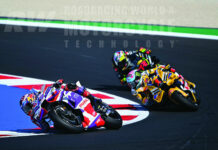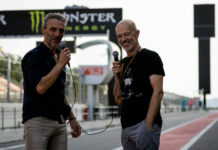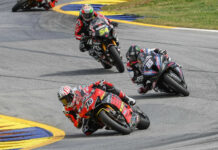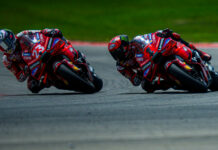Copyright 2002, Roadracing World Publishing, Inc.
From an e-mail:
Subject: VIR Cornerworking (you can print this)
I just read the piece on the VIR cornerworking deal with Hayden’s bike. I agree there is a problem that needs to be looked at a little closer.
On Saturday, I took the Red Bull track ride. I took my street-legal pit bike on the course because I felt like I wanted to see the entire venue first-hand. It seems as the specating at VIR is in a nice setting, but you can’t get to both sides of the track like you can at a place like Mid-Ohio, for instance.
Anyway. I ran my XR100-carb-equipped CT70 wide open for the entire session & on the last lap, I ran out of gas. I figured I’d look around & a cornerworker would see me. Wishful thinking on my part. No cornerworker stations were within an eyeshot of my spot on the track. I didn’t know what to do. I rolled the bike onto the grass & figured a truck would come eventually. That didn’t happen, either.
As I was waiting, I was chatting with some fans on the other side of the fence. After a couple of minutes, I asked if they had any gas. They handed me a can & I was able to start the bike.
At this point, I didn’t know if I should pull out onto the track in fear that I would get collected by a 100 mph Supersport bike in the soon-to-happen practice session. I putted along the infield to a cornerworker station & pulled up to his gazebo.
As the quiet engine of my CT70 idled, I had to yell to get his attention because he had his headphones on & wasn’t aware of my approach or presence. He turned to see me & was VERY surprised that I was on a little bike on the infield at the opposite end of pit in/out.
“How’d you get out here?!” he yelled. I explained I was a on the track ride & ran out of gas a few minutes prior. I asked if he could open the gate & he let me back in the infield.
As I rode back to the pits, I realized that absolutely no cornerworkers were aware of my presence on the track. If any cornerworker had seen me, he would have radioed & they all would have known. When my bike ran out of gas, the rear wheel actually locked. I could have been thrown from it at a lofty 50 mph, nonetheless, nobody would have seen it happen.
I was amazed of the series of events that had just taken place & it made me wonder what would have happened if it were a real racing incident.
Later that day, we found out what could happen. It didn’t help that the cornerworker was literally strolling to Haydens bike as it burned.
I watched the live feed as it happened & Earl Hayden actually said “could he have walked any slower?”
Enzo Assainte
From another e-mail:
A note of agreement with Stephen Robinson regarding the cornerworking crew reactions as seen on television for the past two AMA weekends. As a relatively regular cornerworker for the AFM for the past 7 years, I am pretty proud that we do our job well enough to get the praise that riders like Stephen and many of the top AMA and world riders have given us. I also know the AMA has been to VIR only twice now, and by the worker response, I am guessing that worker crews at both recent tracks were indeed short handed (and more than likely more accustomed to auto races).
I think they did what they could, but I agree that it was not what I would expect if I were a rider or a turn marshal. (My wife caught me screaming ‘Where are the Turn Workers?” more than a few times…) And from watching tapes of races I have worked, I know the cameras rarely catch us, let alone at our best.
However, it appears that more attention needs to be focused on ensuring each set of turns is staffed by an appropriate number of experienced workers at each AMA event. While they don’t need 20-30 workers on a turn like the FIM required at Laguna, 2-3 handlers per turn segment, in addition to the main communicator and flagger is generally appropriate at this level.
Following the Sears Point race, many interested and very experienced AFM workers submitted their names for consideration for what was represented as a potential new data base of experienced workers willing to travel to other venues. I assume the AMA has made this available at each event since, so that perhaps during this long off-season, the AMA safety staff will be able to compile and make use of a list of those willing to travel from around the country to assist at the tracks that would like/need more coverage.
Jim Douglas, AFM #143-W
AMA #549972
And now a differing viewpoint, again via e-mail:
AFM racer Stephen Robinson states:
“Then at VIR, I watched in complete amazement as Nicky Hayden’s bike sat for minutes on end (sound familiar?) before anyone bothered to check on it, or *hey* pick it up (I know, radical thinking on my part). Then the RC-51 that costs more than most of us make in a year bursts into flames and THERE ARE STILL NO TURNWORKERS!! Finally, someone bothers to show up, and Nicky has to put the thing out himself.”
After reading this, I went to my TV and rewatched the crash in question. It took approximately 1 minute and 50 seconds from the time Nicky’s front wheel lost traction for Nicky and the cornerworker to begin fighting the fire.
Less than two minutes.
I think this is a rather good response, and wish to commend the cornerworkers that responded to Nicky’s crash.
In my experience cornerworking for MARRC at Summit Point, and both CCS and the AMA at VIR, I have learned a few things.
When dealing with a crash, the corner worker must think of his own safety first. Then the safety of the riders on the track. Last, but not least, the safety of the downed rider. This is what I have been taught by both MARRC and AMA cornerworking schools.
In this case, Nicky was obviously not seriouly injured. The closest cornerworking station was ACROSS the track, and some ways from where Nicky’s bike came to lay. From what I can gather from the televised race, the track was STILL HOT when the first cornerworker approached the bike. That means that cornerworker who responded either had to wait for a clear spot to cross the track, or that he came from another station. That section of track has a lot of elevation, and it’s difficult to move quickly when carrying a 50+ lb. fire extinguisher. (VIR uses “Cold Fire” extinguishers which use water mixed with a chemical agent. They are heavy and cumbersome, as I found out last year while working the AMA event at VIR.) Don’t forget that the cornerworker has to move through an impact zone to get there. (While the track was hot.) This means that he has to keep an eye on oncoming traffic and while moving to the downed bike.
In my opinion, the cornerworkers did everything by the book in this situation, and did it quickly and efficiently. There was no need to endanger their own lives, or the lives of the riders on the track, by crossing a hot track, or by placing themselves in an impact zone beside a hot track. If Nicky had been unconscious or immobile beside the bike, that would have been a different story. Since he was obviously OK, and out of danger, their response was appropriate.
Cornerworkers are the unsung heroes of road racing, and I commend them for their time, efforts and professionalism.
Regards,
Sean Jordan
Mid-Atlantics CCS #779, WERA #778
Centreville, Va
Further Updated Post: More On VIR Cornerworking, Cornerworker Placement And Race Control
Further Updated Post: More On VIR Cornerworking, Cornerworker Placement And Race Control
© 2002, Roadracing World Publishing, Inc.






